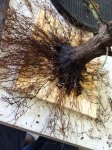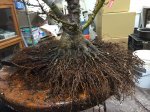Yes, you can up pot.
Tease out 1/2 inch along the sides of the current root ball so that when you add the new soil, they'll be "in" the new soil. That way, they will start growing in the new soil.
A common mistake is to simply stick a rootball in, and backfill with new soil. The roots will be reluctant to grow into the new soil because it's so different.
Of course, the best approach is to bare root young seedlings and arrange the roots out radially, eliminate the downward tap root(s) and attach it to a board so that the roots grow out, not down. Merely setting the tree on a board will help, but the root really want to grow down. And they will push the trunk up if they can! So, a screw inserted up from the bottom of a board into the trunk prevents that.
Colanders really don't help. A large (wide) relatively shallow box works well. Put 1/2 inch of coarse soil (or pumice) in the box. Then place the board with tree attached on the pumice. Secure the board to the bottom of the box. Leave an inch or two of space between the sides of the box and the edges of the board. Roots will radiate out from the trunk horizontally until they get to the edge of the board, then go down, then will grow in the pumice below the board. Cover the board with a couple inches of soil. Yes, deep. The radial roots will develop and fatten and fuse better if they're buried. They will develop slower if they are exposed.
Leave for two years.
In two years, dig it up. Cut off the roots where they start growing down at the edge of the board. Wash lol the old soil off. You can then rearrange roots that cross. Use a nail driven into the board to hold them in place.
Replace the pumice, secure the board back in place, rebutted. Wait another two years.
Repeat until you're happy with the nebari.
Meanwhile, work the top.
You may have to use a new board every couple repottings.
Colanders, provide no benefit. At least, not for deciduous. For pines, they work great. They provide no benefit for junipers, either. Junipers naturally produce fibrous root systems.


